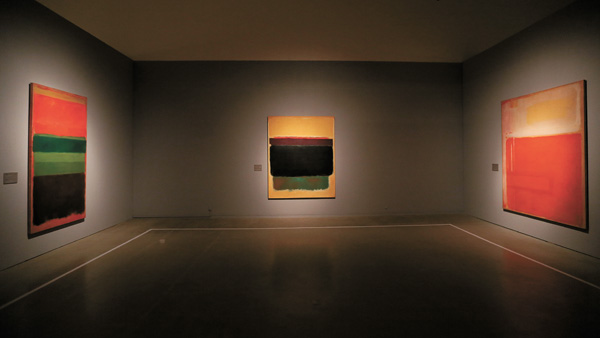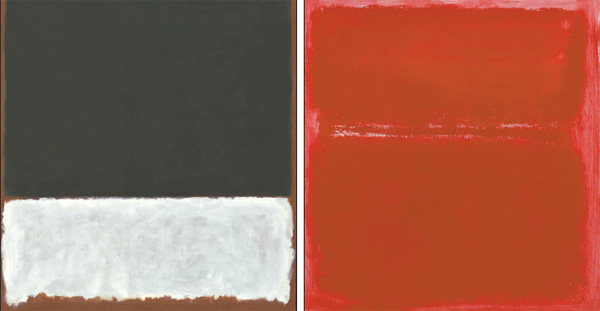Finding solace in Rothko’s fields of color

Mark Rothko’s paintings are installed at Hangaram Art Museum in southern Seoul for a large-scale retrospective of his work that opens Monday. Rothko’s paintings, often categorized as abstract expressionism, are famous for having the power to make viewers cry. The exhibition organizers hope the paintings will relieve stress and help heal the Korean people. Provided by Covana Contents
Koreans overwhelmed by stress might find relief in the abstract paintings of rectangular “color fields” on big canvases by the American modern art master Mark Rothko (1903-70), who killed himself.
Kang Shin-joo, a cultural theorist and one of Korea’s hottest writers now, explained the artist’s work in a press meeting held earlier this month to introduce a large-scale Rothko retrospective in Seoul that starts on Monday.
“Rothko’s paintings are often categorized as abstract expressionism but the artist did not unilaterally express, like Jackson Pollock did,” Kang said. “Rothko tried to express and communicate at the same time.”

Mark Rothko’s 1956 oil painting “Untitled,” left, and his 1970 acrylic painting “Untitled” are part of his retrospective.
The exhibition, which features 50 paintings by Rothko, will be held at the Hangaram Art Museum in Seoul Arts Center. The works are on loan from the National Gallery of Art in Washington, D.C.
“Because the museum’s Rothko room is closed as part of its renovation project, we were able to borrow the most important works in Rothko’s oeuvre,” said Kim Keon-hee, president of the exhibition operator Covana Contents. The company invited Kang, author of several best-selling philosophy books, to give related lectures during the period of the exhibition.
As for emotional communication, Rothko himself said in an interview in 1957, “I’m interested only in expressing basic human emotions - tragedy, ecstasy, doom and so on - and the fact that a lot of people break down and cry when confronted with my pictures show that I communicate those basic human emotions... The people who weep before my pictures are having the same religious experience I had when I painted them.”
In his diary, Kim Whanki (1913-74), one of Korea’s most important and beloved abstract painters, expressed his admiration for Rothko out of all of his contemporary New York artists. Kim asked himself in his diary, “Music, literature, dance and theater make people cry but visual art doesn’t. There can’t be visual art that makes people cry?”
But Rothko’s paintings did. Art historian James Elkins refers to some cases in the first chapter of his 2001 book “Pictures and Tears: A History of People Who Have Cried in Front of Paintings.”
The phenomenon is frequently seen at the Rothko Chapel in Houston, Texas. It is a kind of interfaith sanctuary, which has 14 black paintings by Rothko in an octagonal space of tranquility.
In Section 4 of the Seoul retrospective is a smaller recreation of the chapel. It features seven dark paintings created by Rothko in the same period that he created the paintings for the real Rothko Chapel.
Seeing one of the black paintings on display in the Seoul show, the viewer will feel like they are facing an infinite darkness. It can effect viewers in utterly different ways: To one person, it might be a boundless universe full of possibilities going on for eternity, while to another it would be an abyss of suffering and despair.
Section 5 - the last section - includes Rothko’s paintings from his later years, with colors that returned from darkness to brightness.
“[The] excessively bright and splendid colors, including the vivid red in the 1970 painting ‘Untitled,’ seem to paradoxically show Rothko’s despair and struggle to get out of his abyss,” Kang said.
Then, could Rothko’s paintings make people depressed rather than consoling them? Kang doesn’t think so.
“Rothko’s works don’t press people to pretend they have a happy life ... They just say you are not the only one who suffers. That’s healing.”
The exhibition runs through June 28. Admission is 15,000 won ($13) for adults. Hours are from 11 a.m. to 8 p.m. Go to Nambu Bus Terminal Station, line No. 3, exit No. 5, and walk for five minutes. For details, call (02) 532-4407 or visit www.markrothko.co.kr.
BY MOON SO-YOUNG [moon.soyoung@joongang.co.kr]










with the Korea JoongAng Daily
To write comments, please log in to one of the accounts.
Standards Board Policy (0/250자)